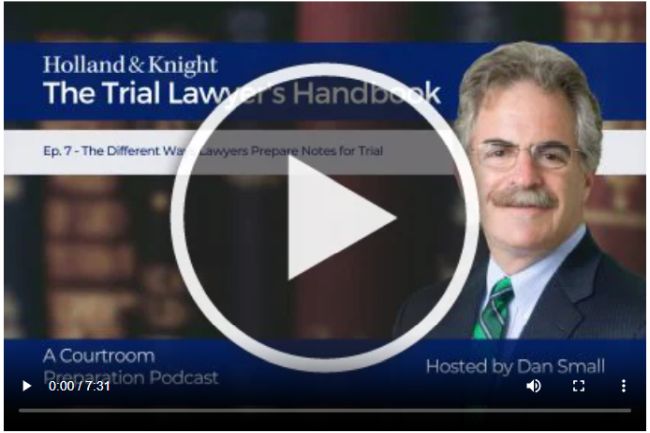In this episode of his "The Trial Lawyer's Handbook" podcast series, litigation attorney Dan Small explains why trial lawyers should always prepare notes before a case. Mr. Small doubles down on the important role notes play in a successful case and analyzes the different approaches to notes, from the no-notes path to a full script. In the end, he emphasizes that "winging it" is not an effective choice and spontaneity is only possible through careful preparation.
Listen and subscribe on Apple Podcasts.
Listen and subscribe on SoundCloud.
Watch and subscribe on YouTube.
Podcast Transcript
It should be obvious that, to try a case properly, you can't just make it up as you go along. "Winging it" is too often a recipe for disaster. The reality is that spontaneity is only possible with careful preparation. It also should be obvious that you can't possibly carry around in your head everything you need to know.
How, then, should you approach the task of organizing your presentation? And what materials should you have with you, at counsel table and at the podium, to help you?
Four Basic Choices When Organizing Your Presentation
There are four basic choices:
- No notes
- A barebones outline
- A detailed outline
- A script
Each option has passionate adherents, and whichever you employ, someone is bound to criticize your choice.
Argument for No-Notes Approach
The argument in favor of a no-notes approach goes something like this:
Your presentation should feel fresh and spontaneous. You want to make a human connection with the jury, and your notebooks and papers and laptops just get in the way of that. Plus, the jury will be very impressed if you do it without any notes.
At first blush, that may sound attractive. But beware. Hardly anything does more damage, in more cases, than this stubborn insistence on extemporaneous speech.
In a trial with any degree of complexity, the no-notes approach is almost always ineffective, and sometimes disastrous. There's simply too much to remember. Cross-examinations made up on the spot may look good on TV or in the movies, but in real life they are likely to be ineffective and disorganized.
As for impressing the jury, you aren't there to show off your prodigious memory or your skill at extemporaneous speaking. You're there to win. Some lawyers use a barebones outline, or rough notes, so that they aren't doing everything completely from memory. Certainly a barebones outline is better than none at all. You use a list when you go to the grocery store. Surely, trying a case deserves at least as much.
However, in many circumstances, the wording, order and backup for questions and arguments are too important to leave to chance and memory. If you're making up every question as you go along, the quality of the questioning is bound to suffer. The same goes for openings and closings. It's not exactly an ideal time and place to be searching for the right words and phrases. Some lawyers say that it's wrong to take a "one-size-fits-all" approach and that each lawyer should do what suits his or her skills best. Sure, that's true, to a degree. And let me also say that I believe you can go too far in the opposite direction as well. I disagree with those who recommend a full script, either for questioning, or for argument.
Three Principle Reasons Why and How Scripts Can Be Taken Too Far
Three principle reasons:
- There is an unbreakable magnetic attraction between the human eye and the written word. The more you have in your notes, the more you will look down at your notes, which means you have abandoned another persuasive tool: eye contact with the jury, the judge or the witness.
- Reading correctly from a detailed script is hard. It takes concentration, which takes away from another important persuasive tool: listening. Many times, I've seen a lawyer so intensely focused on his finely crafted questions that they aren't really listening to, and reacting to, the answers from the witness.
- Reading from a script means you are reading, which can take away from another very key persuasive tool: connecting. As little children, we all like to be read to, but then we learn that we could do it ourselves. Jurors want you to talk with them, not at them. They can tell when you're reading, and it can turn them off. And so, even if, heaven forbid, you were to stumble, go ahead. Try to walk the road down the middle. If you stumble, that's OK. Jurors don't want robots talking to them. They know that if they were up there, they would stumble. It makes you human, and it gives you a connection.
The point is to produce the best, most effective presentation you can under the circumstances. How you do that is ultimately up to you. If there's another approach that works better for you, use it. But it's a fact that too many trial presentations are terribly disorganized and repetitive, and that many lawyers fumble when they make up their questions or arguments on the spot.
Vincent Bugliosi, a noted trial lawyer who prosecuted Charles Manson and later wrote several bestselling books, described his practice this way:
Although the clear trend in the legal profession is toward fewer and fewer notes, I do the opposite, almost to an obsessive, perhaps even unnecessary extreme. The standard explanation of lawyers who religiously avoid the pain and agony of the yellow pad is that if a lawyer does all that preparation and has everything written down, he can't be flexible and can't think on his feet when something not covered by his notes occurs. If that's not a classic non sequitur, I don't know what is. Is instant improvisation and flexibility the domain only of those who are unprepared?
Conclusion
Bugliosi is right. Let's be clear: It's a lot more work to try to lay everything out in advance. Lawyers are often busy, and there simply may not be enough time in the day (or enough client funds to pay for that time). Such is life. But time also can be a convenient excuse. Ask yourself if you are using no notes because you truly believe that your presentation will be better without them, or because you just don't want to spend the time needed to create effective notes. If you have the time, or can make the time, there's no reason not to try to get it right.
In short, working without notes, working "without a net" as they say in the circus, almost always leads to a disorganized presentation at best. It's a bad idea. Don't let anyone talk you into it.
The content of this article is intended to provide a general guide to the subject matter. Specialist advice should be sought about your specific circumstances.

